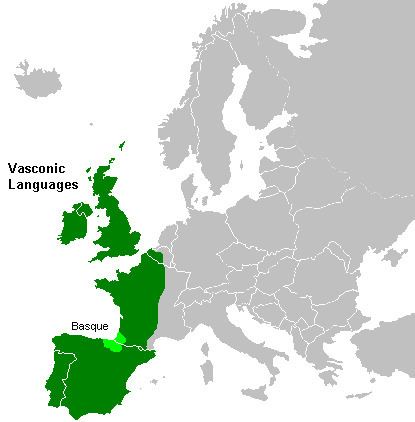 | ||
The Vasconic substratum theory is a proposal that several western European languages contain remnants of an old language family of Vasconic languages, of which Basque is the only surviving member. The proposal was made by the German linguist Theo Vennemann, but has been rejected by other linguists.
According to Vennemann, Vasconic languages were once widespread on the European continent before they were mostly replaced by Indo-European languages. Relics of these languages include toponyms across Central and Western Europe.
Proposal
Vennemann (2003) proposes that after the last Ice Age, Vasconic people (perhaps coming from Africa) resettled all of Western Europe. They gave names to the rivers and places. These names often persisted after the Vasconic languages were replaced by Indo-European languages in most of their area. The present Basque area in northern Spain and southern France is postulated to be a relic. This is based on parallelisms in Old European hydronymy that have been noted by Hans Krahe, and in culture by Marija Gimbutas, that are suggested to be relics of a pre-Indo-European substratum. Theo Vennemann believes that one of the substrata is Vasconic because typical elements of pre-Indo-European toponyms can be explained through the Basque language, for instance the element aran, Unified Basque haran "valley", in names like Val d'Aran, Arundel, or Arendal. However, most linguists believe that the probability of the hydronyms to have Indo-European origins is greater.
Another piece of evidence for the Vasconic language, according to Vennemann, is the persistence of vigesimal (base-20 counting) traits in Celtic, French, Georgian, the Resian dialect, and Danish. Vennemann regards the vigesimal system as a trait of the Vasconic language.
Vennemann also adduces evidence from genetics and blood types that show that the Basques share characteristics found throughout Central and Western Europe, especially in typical areas of retreat-like mountains.
Vennemann developed his ideas in a series of papers which were collected in a book called Europa Vasconica - Europa Semitica. A long critical review of this appeared in Lingua 116. This hypothetical Vasconic substratum has been largely rejected by historical linguists. Vennemann's theories on "Vasconic" toponymy and hydronymy were opposed by the British linguist P. R. Kitson in 1996.
German linguist Dieter Steinbauer argued that a language isolate like Basque is unfit for the reconstruction of a substratum language, as there is little historical data for Basque and that Basque itself has adopted many words from Indo-European languages. Steinbauer criticized Vennemann for assuming Basque roots with initial consonant clusters (which are commonly believed to be adapted from other languages), for ignoring indications that the ancient Etruscan language seems more closely related to western Anatolian languages, and for several methodological flaws, stating that "a scientific discourse with Vennemann must face insurmountable obstacles".
